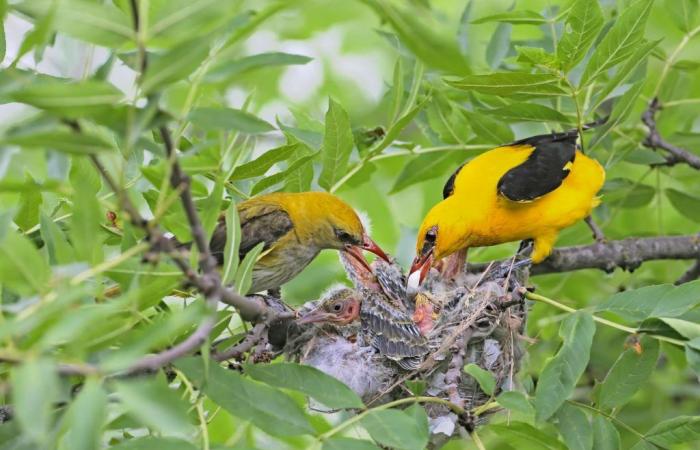Although it is advisable to feed birds with fat balls in winter, do not offer them this opportunity in spring and summer. They must be able to search for their food alone between seeds, berries and fruits or insects depending on the species.
The familiar robin
Scientifically named Erithacus rubecula, It is part of the Muscicapidae family like nightingales or flycatchers. Its orange throat, its dark brown upper plumage, its blue-grey demarcation and the underside of its small whitish body mean that it cannot be confused with another bird. It is also difficult to differentiate a female from a male since their plumages are identical. However, in young robins, the red plastron is not yet formed.
The robin likes to live in forests, near trees. When it lands on the ground and hops, it is trying to capture its lunch of insects and their larvae. It is therefore not uncommon to see it in summer, feasting in the garden!
What you need to know about the robin: it is a species totally protected by the ministerial decree of October 29, 2009.
The chaffinch
You could identify him by his chantchant which is similar to a “tchip tchip”. And if you’re not sure, don’t hesitate to use an app that lets you know how much birdbird the song you record belongs to you!
The Fringilla coelebs is common in gardens, parks and forests, sometimes in city centers. It’s a bird omnivoreomnivorefeeding in turn on seeds, fruits and insects according to the seasonsseasons. In fact, he knows how to adapt to his environment.
Males and females can be identified by their different coats: light brown body, grey head, black and white wings for the male and grey body and darker grey wings for the female.
What you need to know about the pinsonpinson trees: a species threatened in the 1950s due to the massive use of pesticidespesticides et insecticidesinsecticides, the number of finches in France is now stable. The chaffinch is also fully protected.
The cute wren
The adage “the smaller the cuter” could perfectly be attributed to it since it is one of the smallest birds in Europe.
The male builds his nest in a recess of murmur or in a cavity of a rock or tree or between the interstices of a pile of boisbois, it therefore lives at a moderate height. Its nests are clearly identifiable: spherical, often in moussemousseotherwise in straw and dead leaves.
The plumage of the troglodyte mignontroglodyte mignon is brown streaked with dark brown, its throat and the underside of its small body are a little lighter and its wings like its upper part remain a little darker. Her becbec is thin and pointed, characteristic of birds insectivoresinsectivores. Small, males and females have similar plumage, it remains difficult to differentiate them. Rather fearful, it is especially recognizable by its song punctuated by rolledrolled.
The wren is protected by the ministerial decree of October 29, 2009.
What you need to know about the wren: the male builds several nests and, once completed, the female chooses the one that suits her to stop and lay her eggs.
The European oriole
It is difficult to observe this shy bird, which often perches on the top of a tall tree and rarely shows itself on the ground. But if you do spot it, you will easily recognize it by its bright plumage which suggests that it is a tropical bird. The male’s body is bright yellow, its lordslords (between theeyeeye and beak), its wings and tail are black and the female has colorscolors identical, but blander. The oriole’s beak is pink and quite thick, ideal for catching beetlesbeetleslarge caterpillars and butterflies, grasshoppersgrasshoppers and bumblebees.
Pay attention to your fruit trees this summer because the European golden oriole particularly appreciates cherriescherriesblackberries and raspberriesraspberries !
Migratory birdMigratory birdit flies at the end of summer to the countries of southern Africa to return in spring.
What you need to know about the European oriole: the male arrives in Europe before his female to identify his territory where the nest will be built and the eggs laid. Once the chicks are born, they both take care of them!






